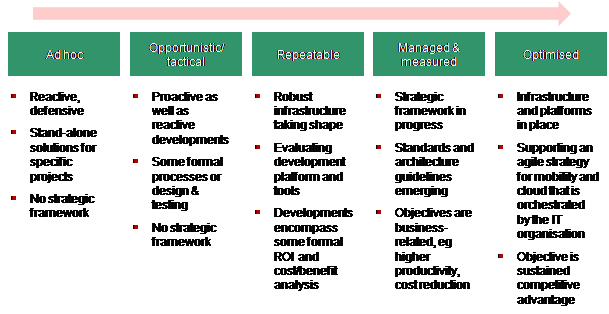Microsoft’s mobility platform means business
This post is by John Delaney, Associate Vice President, European Mobility, IDC.
Microsoft’s CEO Satya Nadella recently said that the company is to evolve towards a mobile first, cloud first world of business. In this world, mobile and cloud technologies are intrinsically linked – mobile devices, connected to the cloud, will give employees access to their business resources wherever and whenever they need it.
Microsoft is among the companies that are most strongly placed to deliver on the intersection between the two technologies. IDC has worked with the company to produce some research which looks at the mobility strategy of modern businesses and how Windows Phone 8.1 is positioned to fulfil the needs of this market.
My colleagues and I are thinking deeply about when, and how, enterprises will finally unleash the full power of a mobile first IT strategy. To provide a framework for our analysis of this evolution, we’ve drawn up the IDC’s Mobile Maturity Model for enterprise IT. The model defines five stages of maturity, which are very briefly summarised below:
The IDC Maturity Model for Mobility in Enterprise IT
Source: IDC, 2014
Our recent research has found that the majority of European organisations are in the “opportunistic” and "repeatable" stages of maturity. In these phases, IT departments are getting to grips with the idea that they must shift their focus away from dealing with the potential problems of mobility, and towards harnessing the power of mobility to deliver positive benefits to their business. However, they are still only at the very early stages of developing the processes, policies and frameworks that characterise a mature approach to IT development.
Most organisations have a long journey ahead before they reach the "managed" and "optimized" stages, in which mobility and cloud form the foundations of enterprise-wide IT developments that are geared to delivering sustained competitive advantage.
- Nearly half of CIOs in our most recent European survey stated that their biggest mobility challenges are OS/device management and cost control.
- Only one-quarter of organisations are working on advanced mobile initiatives such as application lifecycle management
- Only 15% of organisations have rolled out two or more mobile apps.
However, the adoption of mobility by enterprises is rapidly evolving. One of the most interesting findings from our research was the increasing tendency for European enterprises to take a choose-your-own-device (CYOD) approach to device procurement, in preference to the full bring-your-own-device (BYOD) model, thus shifting platform selection back to IT rather than end users. There are several reasons for this, not least of which is the fact that employees often feel unhappy about giving IT people control over their personal property.
This shift of device selection back towards the enterprise is among the current trends that are combining to present Microsoft with a massive opportunity in enterprise mobility. The newly released Windows Phone 8.1 aims to address that opportunity by encompassing substantial changes in both the platform itself and in the business model that underlies it:
- Device makers will no longer be charged for the licence to use Windows in devices with screens smaller than 9 inches.
- Windows Phone 8.1 includes enhanced support for the security and management of Windows Phone devices in enterprise deployments, and has addressed issues surrounding support for mobile device management systems and the use of VPNs.
Some commentators have described Windows 8.1 as "playing catch-up with Apple and Android". To a certain extent, one can see why: Apple added a suite of important new enterprise features in 2013 with iOS7; and device makers have never been charged a licence fee for using Android.
But the limited characterisation of Windows 8.1 as a "catch-up" release misses the point. With Windows 8.1 Microsoft has addressed all of the issues that have hampered its uptake by enterprises, and at the same time it has enhanced the advantages that it offers to enterprises in comparison with iOS and Android.
As a result, Windows Phone 8.1 offers enterprises a fully viable smartphone proposition, and one which means that enterprises no longer need to choose between:
- the consistency, ease of use and strong security offered by iOS devices, and
- the variety and wide range of prices offered by Android.
With the availability of Windows Phone 8.1, consistency and variety are no longer an "either/or" proposition: enterprises can choose to have both.
